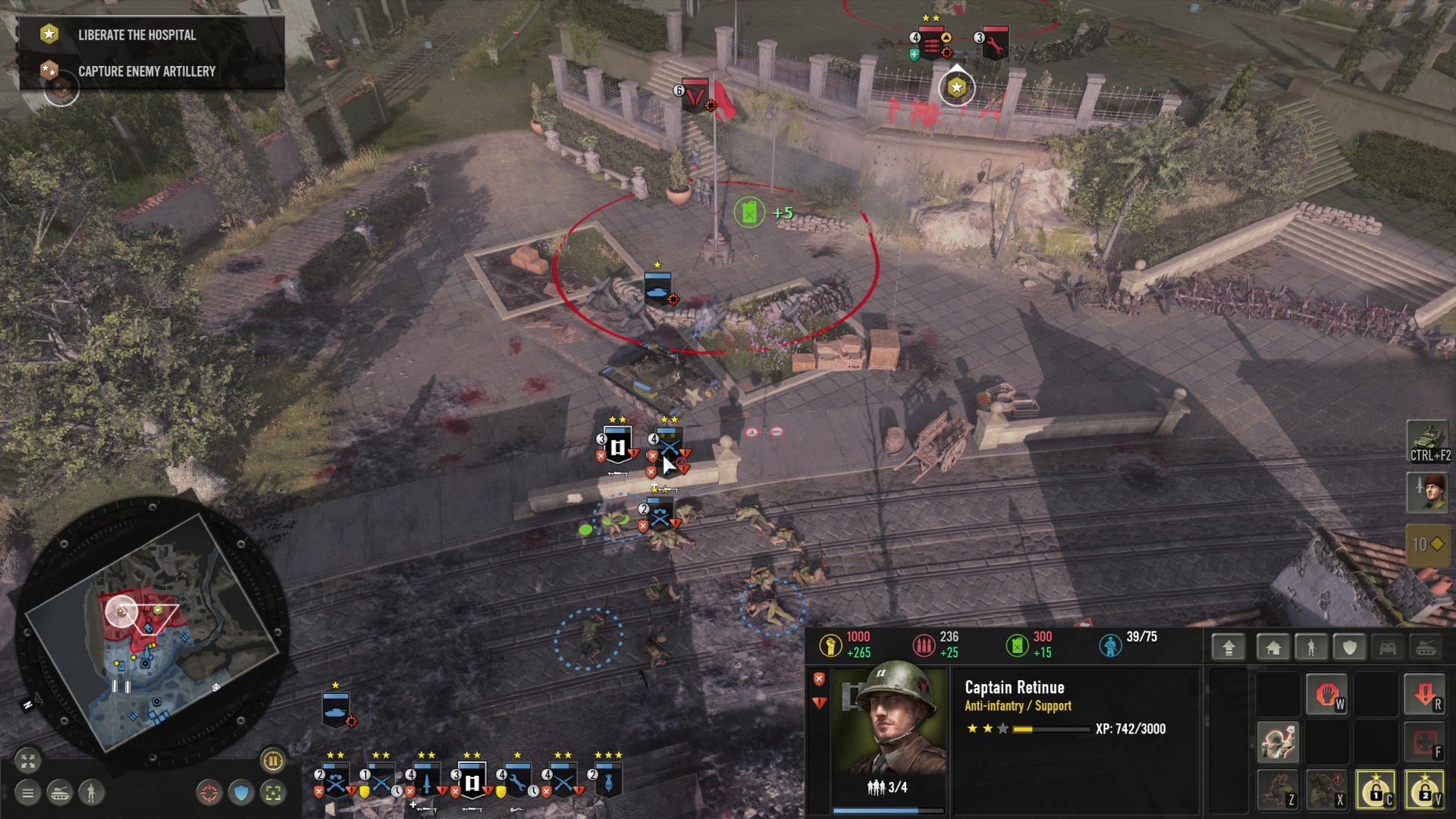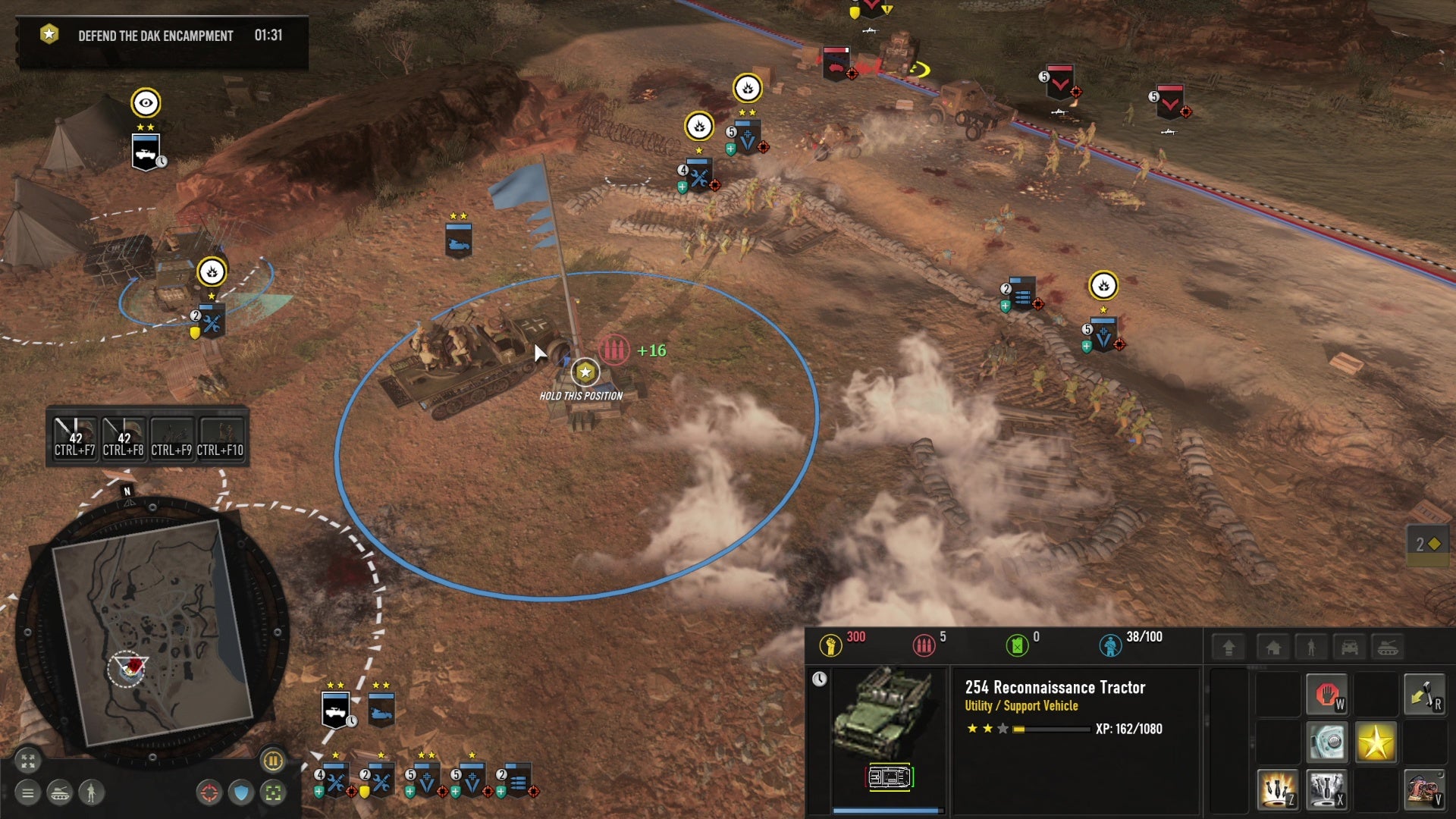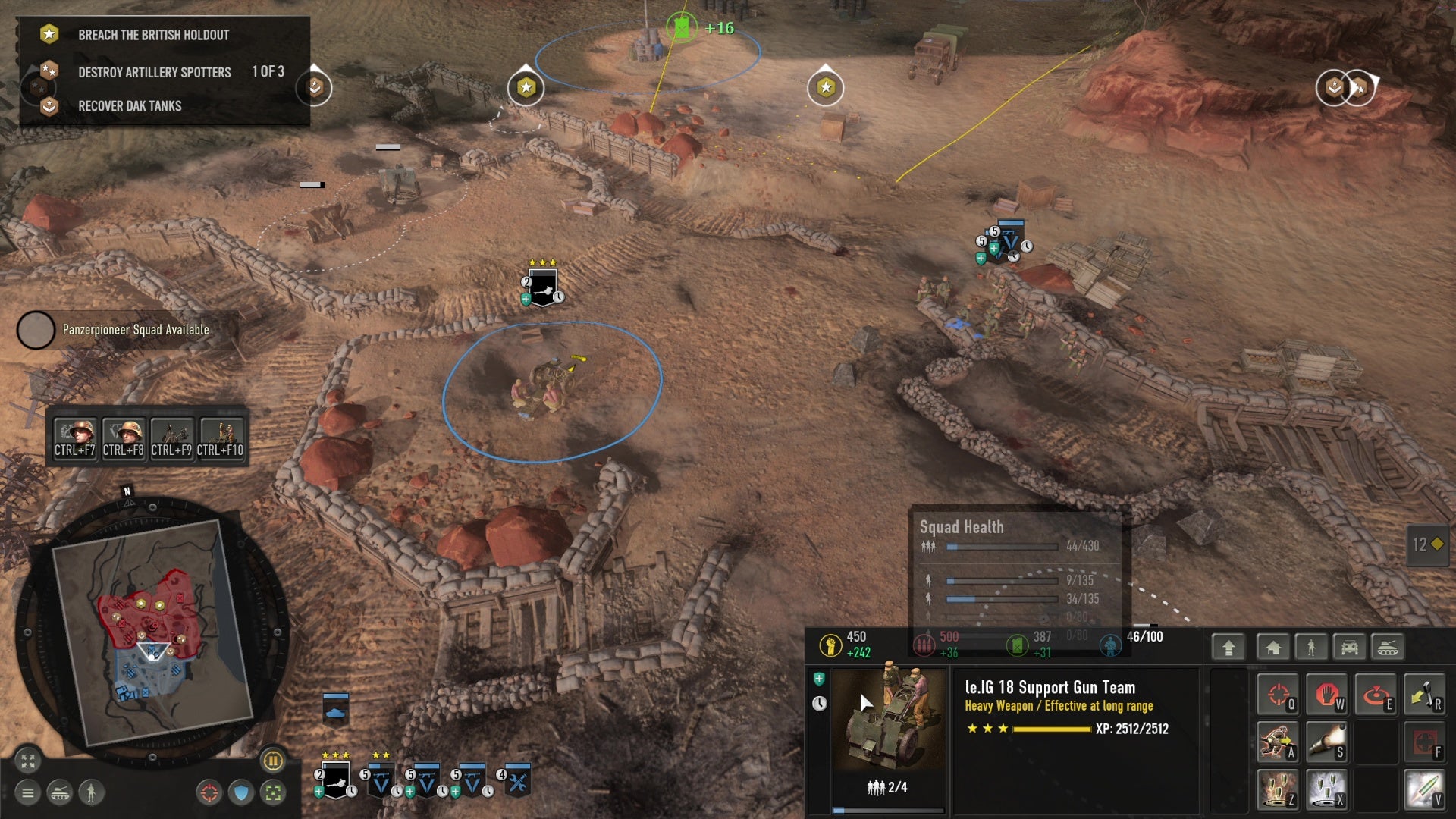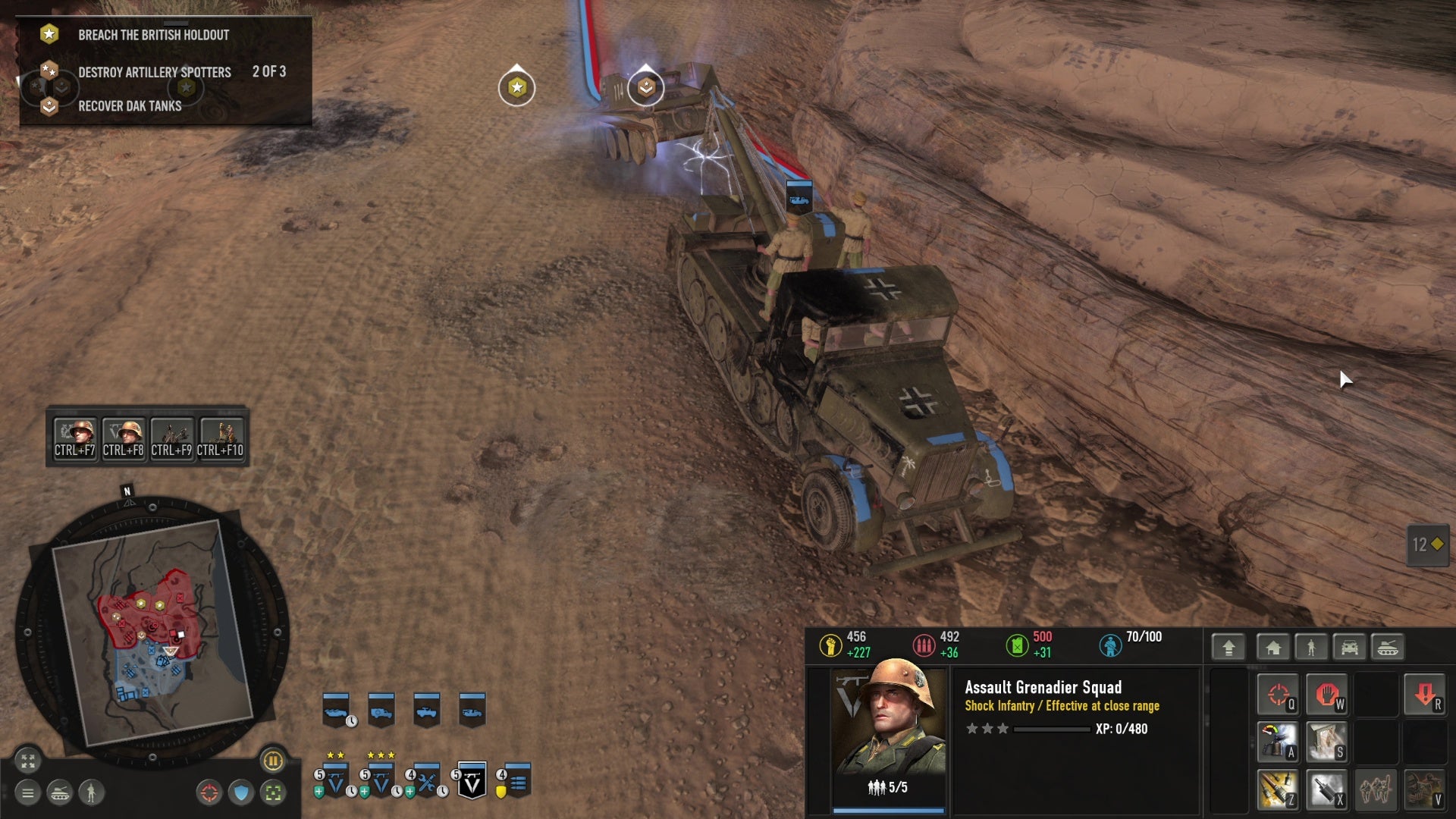Imagine my surprise, then, when I came to preview the latest build of Company Of Heroes 3’s dynamic, Total War-style Italian campaign and seemed to be, you know, actually making some pretty steady progress as I pushed up its mission maps. I was, admittedly, only playing the opening levels of this particular campaign, and I also had the aid of a handy M4A1 Sherman tank providing some welcome backup muscle. But during my four hours with it, I felt more in control of the battlefield than I’ve ever done while playing COH2. I was making excellent use of its reinforcement options, and heck, I was even remembering to tell units to retreat back to the nearest aid post so I didn’t lose the buffs they’d earned through their new EXP-driven promotions and veterancy bonuses. Then I played a mission from its more linear North African campaign, and had a very rude awakening indeed. Why, hello, frantic pressure and torrents of death bullets from Company Of Heroes 2 again, it’s been a while. I later learned that the aptly named ‘Gazala’s Cauldron’ mission was actually taken from the middle of Company Of Heroes 3’s North African campaign, which would explain the sudden jump in difficulty (go figure). That, and I was also having to learn a brand-new faction at the same time. However, despite shattering any illusions I had of actually being all right at Company Of Heroes’ WW2 brand of real-time strategy, I came away from my preview session feeling cheerful and upbeat. While hardened COH fans might find those early missions a walk in the shrapnel-littered park compared to Company Of Heroes 2, it’s clear that Relic have put a lot of thought into making their sequel feel manageable and approachable for relative newcomers such as myself. And besides, if that aforementioned Cauldron is anything to go by, you can rest assured that the series’ tense pressure cooker of fast-paced tactical decisions is still very much present and correct, hinting at a much more thorough and inclusive Company Of Heroes than we’ve seen previously. To briefly recap: Company Of Heroes 3 will give you two different single-player campaigns to pick from when it launches on February 23rd next year: the 1943 Allied invasion of Italy, and the 1942 North African Operation where you take control of the infamous Deutsche Afrika Corps (also known as the DAK). Nate (RPS in peace) covered the meat of the game’s dynamic Italian campaign back when Relic first revealed the game last year, so I’d suggest going back and reading his in-depth thoughts on it if you’re in need of a refresher (he also had a good chinwag with the devs about the way they’ve gone all in on tanks for this entry as well, if you’re keen). From my perspective, the Italian theatre looks to be a great addition to the classic COH formula. As a reminder, this operation will see you alternating between those big RTS battles of yore and a more considered, turn-based Total War-style campaign map. A few lingering bugs and slightly wonky tooltips confirmed that delaying the game from November to February next year was indeed the correct decision on Relic’s part, but on the whole I found its mix of turn and real-time combat to be both a refreshing palette cleanser, and a brilliant framing device for its larger RTS battles. The North African campaign, by contrast, is a much more traditional kind of linear, mission-driven campaign like we’ve seen in previous COH games. I was only plonked into a single mission during my preview session, making it hard to tell exactly how much connective tissue there will be between battles, but much like COH2, the Gazala’s Cauldron started with a small cutscene setting up the skirmish to come. Since you’re playing as an Axis power fighting the British in this campaign, Relic have chosen to centre these story segments on a Jewish Berber family from the region, showing the devastating impact the DAK had during their aggressive push through the cities of Ajdabiya, Tobruk, Gazala and the first battle of El Alamein. “We felt it was important to show the impact of the war had on the people,” Relic’s VP of production David Littman told me when I asked him about the challenges of telling this kind of story. “Our players have been asking for [the Deutsche Afrika Corps] faction for many, many years, and they’ve been asking for a campaign that put you on the Axis side. […] But at the same time, we didn’t want to turn them into heroes. You could always play as the German side in our game since COH1 in multiplayer, but this is the first major campaign that we’ve launched with them. So it was just important that we show both sides. “So while you’re playing as the Afrika Corps, after your missions you’re going to see the impact it’s having, and we follow this Jewish Berber family that are looking back at the war and what it did to, not just the war itself, but the innocent people living in the area. We’re not making a game that changes history, […] but now you’re seeing stories that happened within that.” Of course, only time will tell whether these story beats will have the intended effect when they’re sandwiched between big RTS battles that demand every last scrap of attention to eek out a victory, because man alive, the Brits definitely had me on the backfoot for most of my preview session, and getting a foothold in its ridged desert terrain was a real test of tactical mettle. When we meet the DAK in Gazala, they’re preparing for an attack, holding out as long as possible until your commander Erwin Rommel is able to send out reinforcements. Immediately, my COH2 instincts started to kick in, and I set my engineers to work laying down barbed wire, extra sandbags to provide some cover, and a smattering of mines to catch any British vehicles they might send off guard. On my first attempt, they almost did me in, demolishing my anti-infantry Panzerpioneers and anti-air Half-track truck with ease (although it might have helped if I’d brought my machine gun team forward a bit rather than keeping them tucked away at the back). It was only three and a half minutes of real-time that I actually had to defend my outpost for, but even that fleeting skirmish felt much more in keeping with what I’ve played of COH2. Eventually, Rommel’s reinforcements arrived, and it was time to push out and capture the remaining fortifications further up the map. Armed with a reconnaissance tractor, these speedy little support vehicles were able to mark rough enemy locations in the surrounding fog of war, providing handy targets for my long-range support gun teams and hardy Panzer tanks. However, the real vehicular star of the show was my recovery truck. Half tank, half pick-up truck, these enormous lads were able to repair and transform other broken down, bombed out vehicles littered around the map, including some fallen DAK tanks, to add them to my arsenal. Indeed, despite Relic saying previously that they’re putting a greater emphasis on infantry combat in Company Of Heroes 3, I felt the North African Gazala mission was still very much focused on effectively deploying your armoured, mechanised wheelie lads compared to your boots on the ground. Indeed, the Brits were regularly pelting the battlefield with rockets and long-range artillery fire as I inched my way up the map, making it tricky to seize enemy territory without everyone getting instantly mullered. Back-up from my own rocket launcher trucks and support gun teams was essential to capturing enemy camps, and making sure my HQ was appropriately teched up to support that strategy became a key part of the mission’s early rhythm. In truth, I never managed to breach the British Holdout sitting at the top of the map, but chewing over how to approach and tackle their hilly outcrop defences offered up a satisfying level of challenge. I’m not sure I had much time to think about all the damage I was doing, mind (only the scores of DAK troops I was sending into oncoming machine gun fire), but as I mentioned earlier, this was but one mission in a much larger campaign, so we’ll have to wait and see if the local Berber communities have a larger role to play in the operation outside of their mission-bookending story scenes. One thing that did surprise me, though, was how little I needed the game’s new tactical pause function. Given the troubles I’ve had with COH2’s campaign over the last couple of months, I was expecting this to be the key to unlocking Company Of Heroes 3 for me. Happily, I barely even touched it during my time with the Italian campaign, and I only felt the need to call on it a couple of times during my North African playthrough. I certainly appreciated it being there, giving me the option to take a beat and queue up some attacks without the threat of being bombed out of existence in the process, but it was by no means essential to the overcoming what lay in front of me. Once again, though, it’s yet another sign that Relic are covering all possible bases with Company Of Heroes 3, giving players as much freedom as possible to approach this Mediterranean war theatre in whatever way they see fit. If you want to go all-out with a pure RTS approach, you can absolutely do that. If, like me, you prefer the odd breather here and there to gather your thoughts and stretch your jammed up hotkey digits once in a while, you can do that too - and that’s pretty damn exciting, especially when there so much here to sink your teeth into. There may still be a few months to go before Company Of Heroes 3 arrives in full, but barring any more delays for a final spit and polish, it looks like 2023 is going to start with a real bang for wartime RTS fans.




